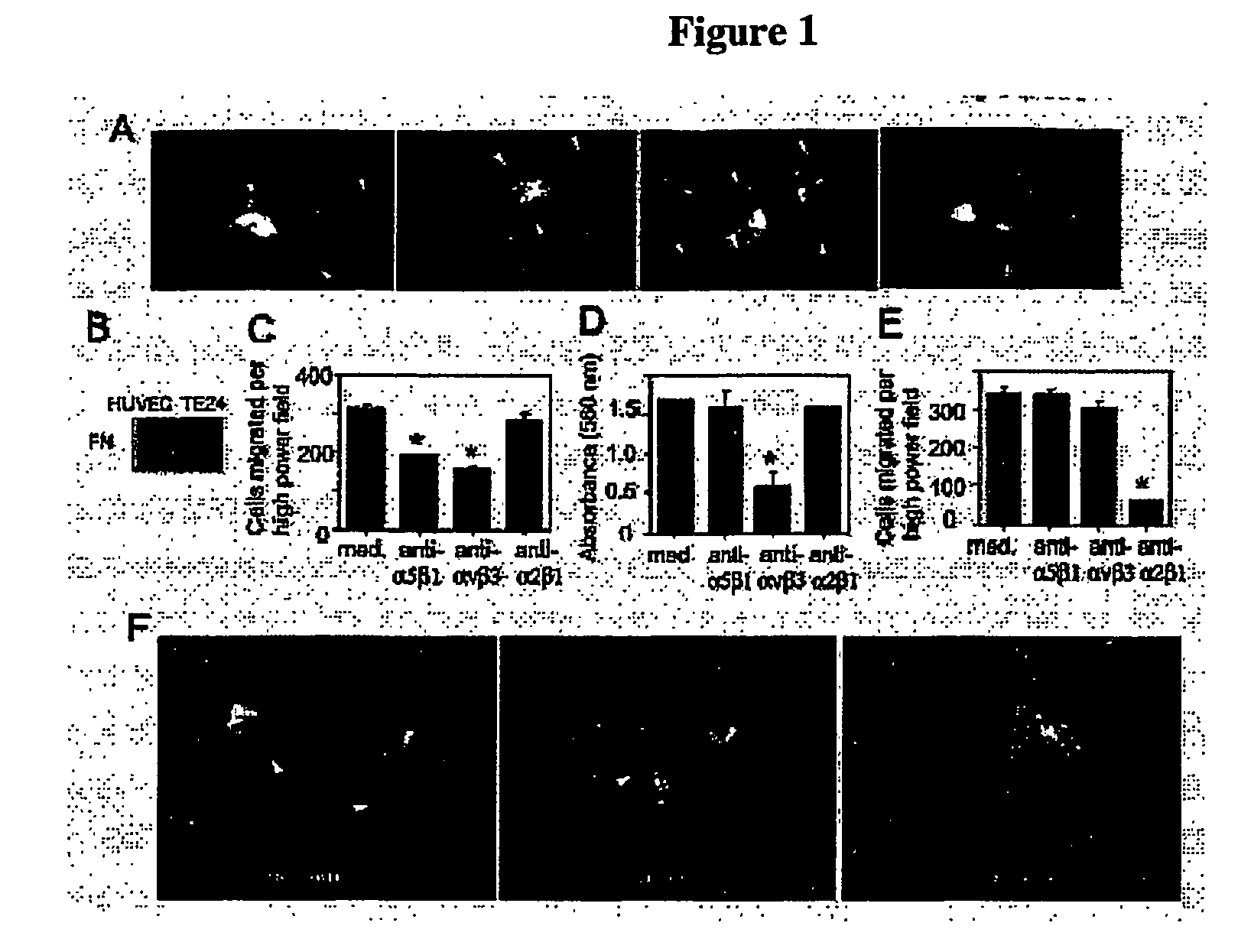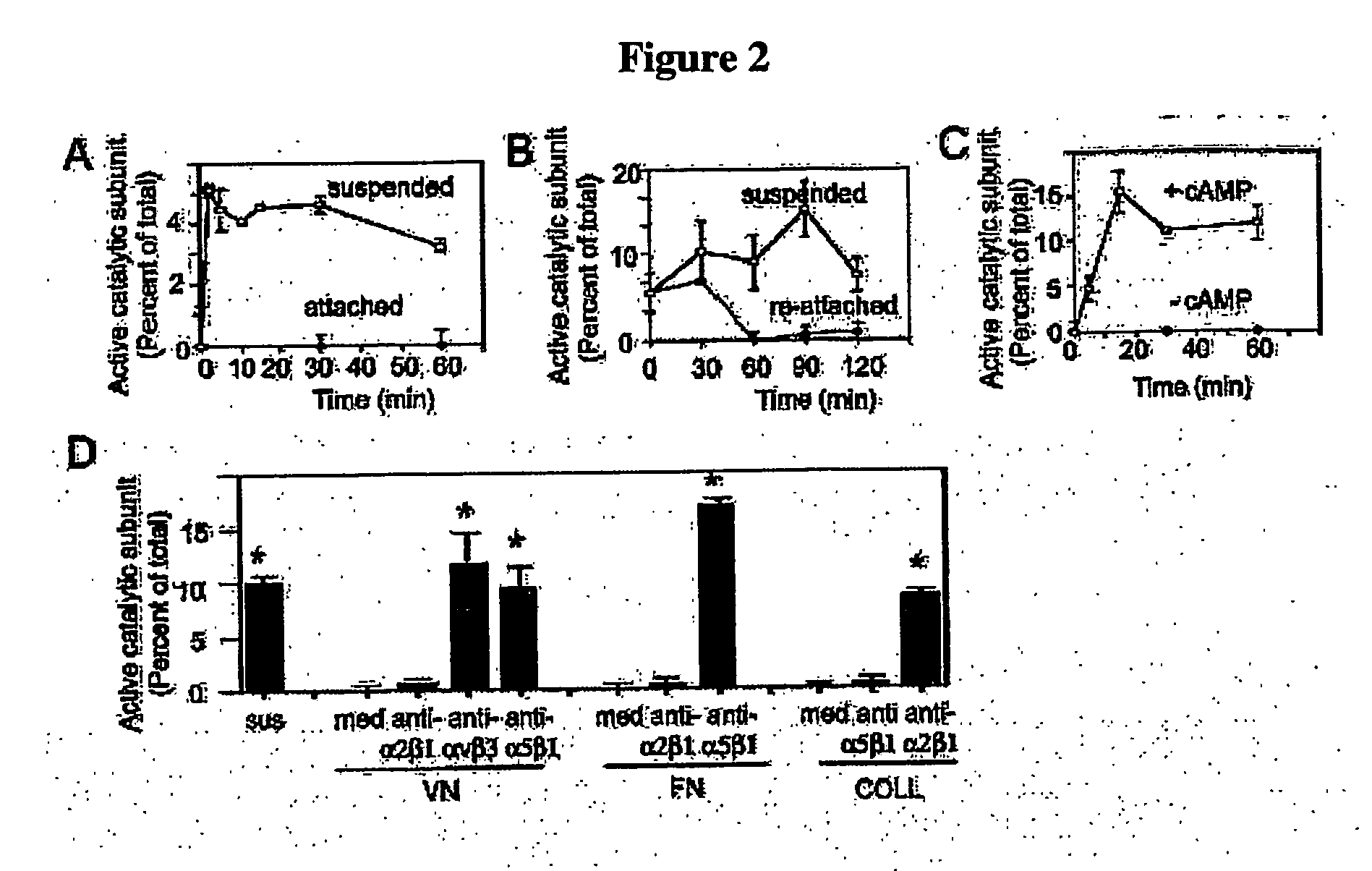Methods For inhibiting angiogenesis, cell migration, cell adhesion, and cell survival
a technology of angiogenesis and cell migration, applied in the direction of biocide, peptide/protein ingredients, genetic material ingredients, etc., can solve the problems of inability to carry out angiogenesis properly, low five-year survival rate of most cancers, and serious side effects of chemotherapeutics reagents or radiation, so as to reduce the survival rate of said cells and reduce specific binding
- Summary
- Abstract
- Description
- Claims
- Application Information
AI Technical Summary
Benefits of technology
Problems solved by technology
Method used
Image
Examples
example 1
Reagents
[0418] Anti-α5β1 and anti-α2β1 antibodies were from Chemicon. Anti-αvβ3 and anti-αvβ5 antibodies were from David Cheresh, Scripps Research Institute. Anti-V5 and GFP antibodies were from Invitrogen. (Invitrogen, Corp., Carlsbad, Calif.). Anti-Rho, Rac, HA and Myc antibodies were from Santa Cruz. (Santa Cruz Biotechonology, Inc., Santa Cruz, Calif.). Tissue culture plastic including transwells were from Costar. (Corning Costar, Corp., Midland, Mich.). Fibronectin and collagen I were from Collaborative Biomedical Products (Bedford, Mass.). Vitronectin was purified from outdated human plasma by denaturing heparin sepharose chromatography. Poly-L-lysine was from Sigma (St. Louis, Mo.). HUVECs, EBM (minimal medium), EGM-2 (bFGF and VEGF, but no FBS) and EGM (2% FBS, bFGF and VEGF) were from Clonetics (San Diego, Calif.). cDNAs were subcloned into topoTA-pcDNA 3.1 V5 / His according to manufacturer's directions (Invitrogen, Carlsbad, Calif.). HUVECs were cultured in EGM. All statis...
example 2
Expression Constructs and Transfections
[0421] N1-GFP (green fluorescent protein) reporter vector was a gift from Dr. David Cheresh, The Scripps Research Institute. dnPKA (RImut) cDNA was a gift from Dr. Stanley McKnight, University of Washington. Murine PKA catalytic subunit (PKAcat) and mutationally inactive PKA (dnPKA; 41) cDNAs (gifts from Dr. Susan Taylor, University of California, San Diego and Dr. Renate Pilz, University of California, San Diego, respectively) were subcloned into topoTA-pcDNA 3.1 V5 / His by PCR-based TA cloning according to manufacturer's directions (Invitrogen, Carlsbad, Calif.). Myc tagged V12 Rac was a gift from Dr. Martin Schwartz, The Scripps Research Institute. HA-tagged V14Rho, N19 Rho, V12Rac and N17Rac as well as Myc-tagged dnPAK and dpPAK were gifts from Dr. Martin Schwartz, The Scripps Research Institute. The sequence and orientation of all constructs were verified by DNA sequencing. Transfections were performed by electroporating 5×106 cells in 300...
example 3
Chorioallantoic Membrane Angiogenesis Assays
[0422] The CAMs of 10 day-old chicken embryos (McIntyre Poultry, Ramona, Calif.) were stimulated with 30 ng bFGF (Genzyme, Cambridge, Mass.) or saline as described in S Kim et al. (S. Kim et al., Amer. J. Biol. Chem., 275:33920-33928 (2000); and S. Kim et al., Amer. J. Path., 156:1345-1362 (2000)). bFGF stimulated CAMs were transfected by direct application of 4 μg N1-GFP, dnPKA or PKA catalytic subunit plasmid DNA or were treated with 250 μM cAMP. Ten embryos were used per group. CAMs were fixed with 3.7% paraformaldehyde prior to excision. Representative CAMs were photographed at 10× magnification. Blood vessel branch points were counted in each CAM at 30× and graphed as average branchpoints above background+ / −S.E.M. per treatment group. Statistical analyses were performed using paired Student's t-test. Experiments were performed 3 times and selected representative experiments are presented. Transgene expression was verified by immunobl...
PUM
| Property | Measurement | Unit |
|---|---|---|
| Cell adhesion | aaaaa | aaaaa |
Abstract
Description
Claims
Application Information
 Login to View More
Login to View More - R&D
- Intellectual Property
- Life Sciences
- Materials
- Tech Scout
- Unparalleled Data Quality
- Higher Quality Content
- 60% Fewer Hallucinations
Browse by: Latest US Patents, China's latest patents, Technical Efficacy Thesaurus, Application Domain, Technology Topic, Popular Technical Reports.
© 2025 PatSnap. All rights reserved.Legal|Privacy policy|Modern Slavery Act Transparency Statement|Sitemap|About US| Contact US: help@patsnap.com



